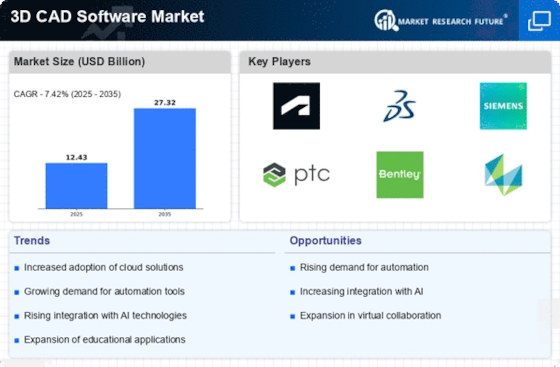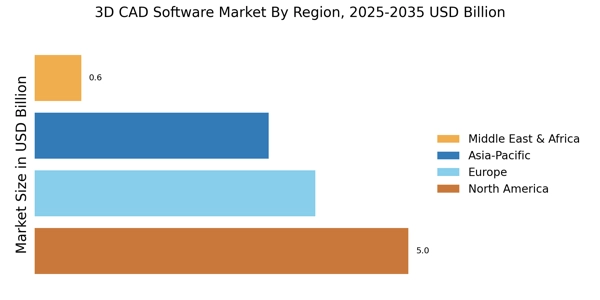Expansion of Educational and Training Programs
The expansion of educational and training programs focused on 3D CAD software is significantly impacting the 3D Cad Software Market. As industries increasingly recognize the importance of skilled professionals in design and engineering, educational institutions are incorporating CAD training into their curricula. This trend is fostering a new generation of designers proficient in 3D CAD tools, thereby increasing the overall demand for such software. Recent data indicates that the number of educational programs offering CAD training has risen by over 30% in the past few years. This influx of trained professionals is expected to drive market growth as they enter the workforce equipped with the necessary skills to utilize advanced CAD software effectively. The emphasis on education and training is likely to create a sustainable pipeline of talent for the 3D CAD industry.
Increased Adoption of 3D Printing Technologies
The integration of 3D printing technologies within various sectors is significantly influencing the 3D Cad Software Market. As businesses increasingly adopt additive manufacturing processes, the need for compatible CAD software becomes paramount. This software enables designers to create models that are optimized for 3D printing, thus streamlining production workflows. Recent statistics indicate that the 3D printing market is expected to reach a valuation of over 40 billion dollars by 2027, which correlates with the rising demand for 3D CAD solutions tailored for this technology. Consequently, software providers are focusing on developing features that enhance compatibility with 3D printing, thereby driving growth in the 3D CAD software sector. The synergy between 3D CAD and 3D printing is likely to foster innovation and efficiency in product development.
Rising Demand for Advanced Design Capabilities
The 3D Cad Software Market is experiencing a notable surge in demand for advanced design capabilities. Industries such as architecture, engineering, and manufacturing are increasingly adopting sophisticated 3D CAD tools to enhance their design processes. This trend is driven by the need for precision and efficiency in product development. According to recent data, the market for 3D CAD software is projected to grow at a compound annual growth rate of approximately 7.5% over the next five years. This growth is indicative of the industry's shift towards more complex and detailed design requirements, which necessitate the use of advanced software solutions. As companies strive to innovate and improve their product offerings, the demand for 3D CAD software that can accommodate intricate designs is likely to continue to rise.
Technological Advancements in Software Features
Technological advancements are playing a crucial role in shaping the 3D Cad Software Market. Innovations such as artificial intelligence, machine learning, and augmented reality are being integrated into CAD software, enhancing user experience and design capabilities. These advancements allow for more intuitive interfaces, automated design processes, and improved visualization techniques. As a result, users can create more complex designs with greater ease and efficiency. The introduction of these cutting-edge features is expected to attract a broader user base, including small and medium-sized enterprises that may have previously been deterred by the complexity of traditional CAD software. The ongoing evolution of technology within the 3D CAD sector is likely to drive market growth as companies seek to leverage these advancements for competitive advantage.
Growing Emphasis on Collaborative Design Processes
The 3D Cad Software Market is witnessing a growing emphasis on collaborative design processes, particularly as teams become more geographically dispersed. The need for real-time collaboration tools has led to the development of cloud-based CAD solutions that facilitate seamless communication among team members. This trend is underscored by the increasing number of projects that require input from multiple stakeholders, necessitating software that supports collaborative features. Market analysis suggests that the collaborative CAD software segment is expected to grow significantly, driven by the demand for enhanced teamwork and project management capabilities. As organizations recognize the benefits of collaborative design, the adoption of 3D CAD software that supports these functionalities is likely to expand, further propelling the market forward.


















Leave a Comment